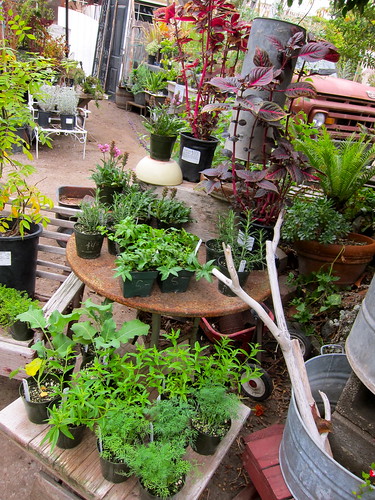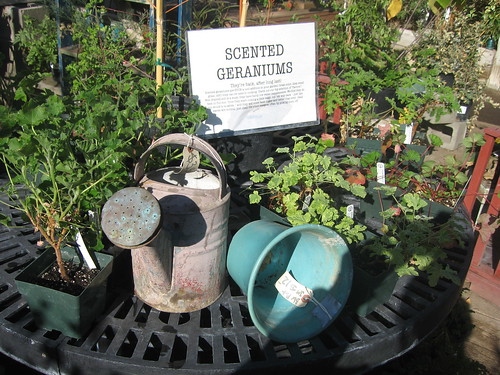October is a great time to plant - our winters are mild enough that we don't have to worry about bad cold snaps, and nothing is better for a newly planted garden than some rain! We have some great varieties of the 'standards' that every herb garden needs: basil, oregano, thyme, dill, cilantro and chamomile, just to name a few. We also go in some cool season veggies - yes, you can grow veggies this time of year! - including broccoli, artichoke, eggplant and spinach - nothing beats having some fresh veggies from your own garden in late winter!

We also got in about six different varieties of scented geraniums, and if you know anything about us, you know we looooooove our scented geraniums! They are super easy to grow, can be used in baking and teas and they small fabulous! We have some of our favorite varieties in right now, including peppermint and apple.

And of course, some unusual plants were included in this order too; check out a few examples below:
Lemon grass (Cymbopogon citratus), a native of India, is widely used in Thai and Vietnamese cooking. Lemon grass is a perennial, which means once you plant it, the grass comes back year after year. Depending on the area you live in the plant will go dormant in the winter. This aromatic herb is used in Caribbean and many types of Asian cooking and has become very popular in the United States. This is a very pungent herb and is normally used in small amounts. The entire stalk of the grass can be used. The grass blade can be sliced very fine and added to soups. The bulb can be bruised and minced for use in a variety of recipes. The light lemon flavor of this grass blends well with garlic, chilies, and cilantro. The herb is frequently used in curries as well as in seafood soups. It is also used to make tea.
Heal All is a perennial herb found throughout Europe, Asia, Japan and the
U.S., and most temperate climates. Its origin seems to be European. Heal-All thrives in any damp soil in full sun or in light shade. Heal-All is edible and medicinal, can be used in salads, soups, stews, or boiled as a pot herb. Used as an alternative medicine for centuries on just about every continent in the world, and for just about every ailment known to man.
If you've never rubbed a leaf of lemon verbena it's impossible to explain its lovely scent. Yes, it's lemon, but yet it's also a captivating fragrance that almost instantly relaxes you. To me, it's the ultimate in aromatherapy. If you grow just one lemon scented herb it should be lemon verbena. Although to grow just one lemon herb would be a shame, since they are all so wonderful! Lemon verbena, aloysia triphylla, is a native of Chile and Peru. Unlike some herbs, lemon verbena will retain its scent for years when dried, which is why it's not only a popular culinary herb, but also a potpourri ingredient. You can use lemon verbena in place of lemon zest in recipes. Virtually any fruit salad can be enhanced with its finely chopped leaves. Bury 6 lemon verbena leaves in a cup of sugar that has been placed in a covered jar or container. Use this sugar to top muffins, fruit, or sprinkle on the top of muffin batter before baking.
Curry Plant looks very similar to a Lavender in its leaf stage. But, as the picture to the right shows, it looks totally different in bloom. Curry Plant likes it warm and dry. It is native to Turkey and thrives on sunny slopes where it attracts beneficial insects to its unusual flowers. While not very tasty, Curry Plant smells strongly like Curry spices. But, Curry Plant is not where Curry Seasoning comes from. Curry is actually a blend of many different herbs. The herbs used in real Curry vary from region to region. When Curry Plant is mentioned with food, it is always used sparingly, a few leaves in a mayonnaise or a sprig tucked in a cavity of a chicken. The flavor is not Curry but is strong. It is also difficult to describe. However, trimming Curry Plant in the garden will leave you pleasantly reeking like an Indian restaurant the rest of the day.
Moujean Tea is a native of West Indian scrublands that grows fairly slowly to about three feet. It produces clusters of creamy white flowers that in warmer zones are followed by tiny dimpled orange fruits. Both leaves and fruits are scented of vanilla which is released when the tea is made. The tiny leaves and fruits may be used fresh or dried. They are quite tough so it is necessary to steep the tea for a longer period of time for fresh use and it is nice to grind or pulverize for dried use. This plant is attractive to bees, butterflies and/or birds. Flowers are fragrant. Average Water Needs; Water regularly; do not overwater. Requires consistently moist soil; do not let dry out between waterings. Full sun to part shade, can grow up to 6-8 feet, but easily contained with pruning.
These are just a few of the interesting plants we have in stock right now - come in and see them for yourself!






No comments:
Post a Comment